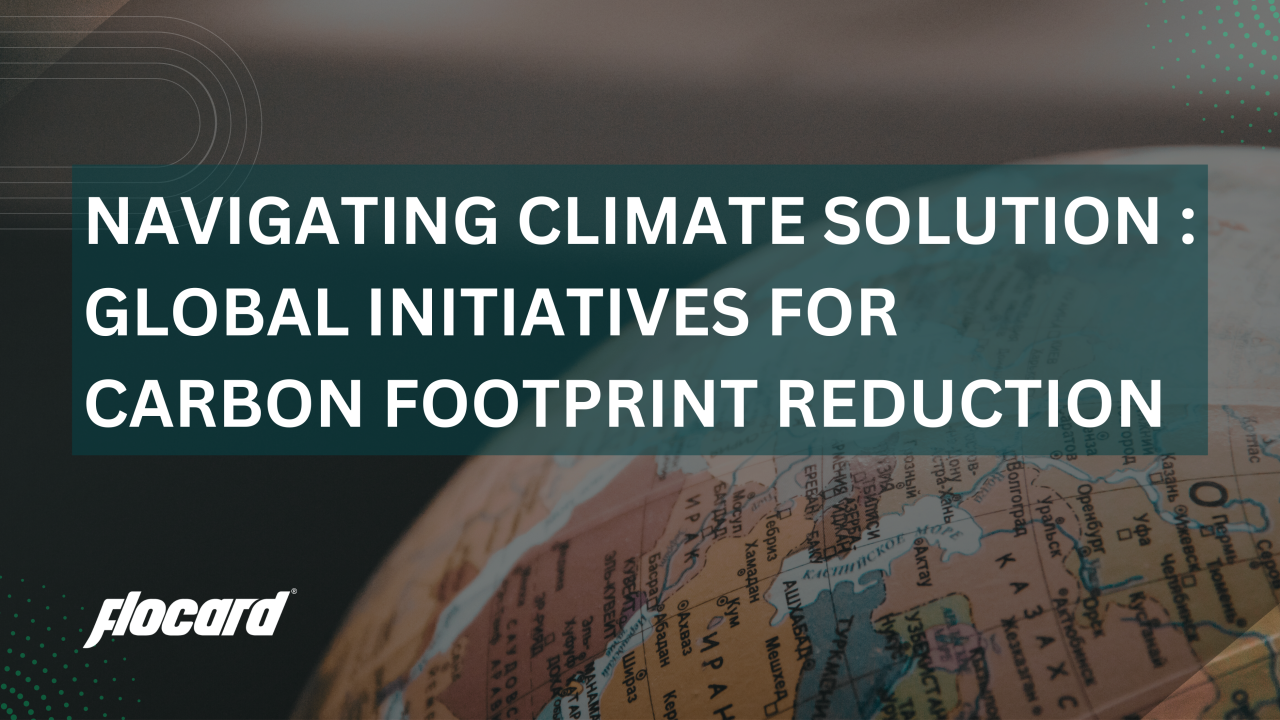Global Policies Shaping the Carbon Footprint Landscape: A Dive into Sustainability Efforts

Global Policies For Carbon Footprint Reduction
What is Carbon Footprint and why is it important to understand?
According to WHO, “a carbon footprint is a measure of the impact your activities have on the amount of carbon dioxide (CO2) produced through the burning of fossil fuels and is expressed as a weight of CO2 emissions produced in tonnes.”
Carbon Footprint reduction is essential to mitigating climate change as these emissions contribute to worldwide global warming and environmental degradation. According to the Annual Global Carbon Budget, 40.9 billion metric tons of carbon dioxide emissions worldwide in 2023, including 36.8 billion tonnes from fossil fuels and industry and 4.1 billion tonnes from land use changes i.e. will rise by 1.1% from 2022. To mitigate the severe effects of climate change.
o mitigate the severe effects of environmental climate change, it is vital to reduce carbon footprint and limit the temperature below 2 degree celsius by The Paris Agreement (2015) under the United Nation Framework Convention on Climate Change(UNFCCC). Various countries and religions have implemented effective and successful climate policies in addressing climate change.
Emission Reduction : Global strategies On Climate Action
The Reality Check Report by The World Bank highlights 25 successful climate policies implemented by countries disparate as Egypt, Niger, China, and Peru. This report provides how Nations coordinates to carry out successful climate policies and on the compromises doing so can require. For example,
- Adopting half-moon techniques (digging large half-moon shapes into the soil) in Niger increases yields and reduces land turnover. Trained households cultivated an additional 0.3 hectares of rehabilitated land by the third year after training. These practices contribute to climate change mitigation, improved resilience, enhanced crop productivity and food security.
- In 2021, China launched national ETS (Emissions Trading Schemes) to contribute in the effective control and gradual reduction of the emission, known as the world's largest carbon market. China’s national ETS regulates more than 2000 power plants in the sectors with annual emissions above 26,000 tCO2, estimated to cover approximately 4 billion tCO2 and contributing about 40% of the country's carbon emission.
- Law 30936 by The Ministry of Transport and Communications of Peru, promotes bicycling as a sustainable and efficient mode of transportation and environmental protection.
- Over the last five years India's solar capacity significantly increased from 21,651MW to 70,096 MW in 2023, world's third largest solar market which reduced carbon emissions, enhanced energy efficiency and provided employment opportunities in this sector. India’s primary energy demand has doubled from the past two decades, making it the third largest energy consumer globally. The Indian Government promotes utility-scale solar projects, household solar infrastructure, mini grids solar power in rural areas through collaborating political and economic framework to set energy efficiency targets by doing various campaigns and strategies. By 2030, India’s target is to reach 500 GW of installed energy production from non fossil fuel.
UNEP(United Nations Environment Programme)
The UN Environment Programme is an International Organization, promotes global cooperation on addressing environmental challenges including climate crisis, GHGs emission, and carbon footprint reduction.The headquarters of UNEP located in Nairobi, Kenya. UNEP collaborates organizations, governments, individuals worldwide to encourage sustainable practices, increase environmental awareness, and contribute to participate in climate action policies through its scientific advisory groups, research strategies and initiatives. It significantly assists The Paris Agreement, adaptation of renewable energy, and transition to a low-carbon economy.
Six essential sectors have been highlighted by the United Nations Environment Programme include energy, industry, transport, buildings, nature-based solutions, and food production as having the need to significantly reduce emissions to limit the temperature below 1.5 degree celsius. It actively participates with several global initiatives in different regions such as Adaptation and Resilience, Climate and Clean Air Coalition, Climate finance, Climate Technology Centre and Network, Mitigation, REDD+ (reducing emissions from deforestation and forest degradation) to address environmental challenges for an emission free future.
Kyoto Protocol
The Kyoto Protocol is an international treaty under The United Nations Framework Convention on Climate Change adopted at COP3, committing parties to significantly reduce their greenhouse gas emissions primarily Carbon Dioxide (CO2), Methene (CH4) and Nitrous Oxide (N2O), aimed address global warming and rising earth temperature on December 11, 1997 in Kyoto, Japan.
This Protocol has provided a framework for reducing carbon footprints through implementing three ‘flexible mechanisms’ i.e. International Emission Trading (IET), Joint Implementation (JI), and Clean Development Mechanism (CDM) .
During the first commitment period (2008-2012) under the protocol, it committed to reducing greenhouse gasses at least 5%
compared to 1990 levels. In 2012 extended commitments to 2020, during the Second commitment period, Parties committed to
reduce the GHG emissions by at least 18% below 1990 levels in the eight-year period from 2013 to 2020. On December 8, 2012,
in Doha, Qatar. It creates a collaborative effort to reduce carbon footprint addressing climate change. In 2015, the Kyoto
Protocol significantly replaced by The Paris Agreement. Though the objective of the both aimed to reduce emissions and
prevent climate crisis.
The Kyoto Protocol is primarily addressed to the developed countries to reduce emissions, while
The Paris Agreement sets a mandatory target to every country associated with this agreement to offset their emissions and
to hold global average temperature below 2°C and pursue efforts to keep temperature under 1.5°C.
The Paris Agreement On Climate Change
It is an international agreement against climate change adopted by 196 parties at the UN Climate Change Conference (COP21) in Paris, 12th December, 2015. This agreement sets long-term initiatives to guide all nations to limiting the global temperature rise to well below 2 degree celsius above pre-industrial level and pursuing efforts to limit the temperature to 1.5 degree celsius by the end of this century. This agreement periodically evaluates the collective progress towards achieving these goals, giving financial support to developing countries to mitigate climate change and creates a global transparency framework towards achieving a net-zero emission world and Sustainable Development Goals.
Every five years, each country associated with the Paris Agreements is required to submit an updated national climate action plan called Nationally Determined Contribution(NDC) to reduce emission and mitigate the adverse effects of climate change.
Global climate action plan has significantly increased by The Paris Agreement. One of the significant outcomes of COP28, 2023, was the agreement on the first ‘Global Stocktake’, a periodic assessment report of the parties collaborative endeavors under the Paris Agreement and encouraged to submit more accurate national climate plans by 2025.
Climate Legislation Worldwide : Global Collaborative effort
Climate change laws are the legal frameworks that regulate the sources and effects of climate change. The Sabin Center’s database at Columbia Law School and The Grantham Research Institute at LSE on climate change and the Environment collaborated together to build an online database of laws, regulations, policies and others that address climate change mitigation, adaptation and disaster risk management. These laws and regulations can be applied in various sectors like agriculture, land use, transportation, commercial and construction.
As per September 2022, over 2,860 climate related laws and regulations are listed in the Climate Change Laws of the World(CCLW), Every 193 parties to The Paris Agreement have at least one law about the climate crisis or net-zero carbon economy. The majority of laws and policies addressing transportation, energy, and land use, land use change and forestry (LULUCF), food security, gender equality, human rights to make a transition of a low-carbon economy. This database shows how climate laws and policies are hyperlink with The Paris Agreement and Sustainable Development Goals (SDGs).
The Paris Agreement is the global framework for addressing climate change with the long-term goal of limiting the global temperature rise to well below 2 degree celsius above pre-industrial level and pursuing efforts to limit the temperature to 1.5 degree celsius by the end of this century, at COP21,2015. The Sustainable Development Goals(SDGs) at the UN Summit, 2015, aimed to achieve 17 goals to create a better planet by the year 2030 that include human rights, gender equality, poverty and hunger,affordable energy, climate actions etc other social, economic and environmental aspects. Countries are required to submit their assessment reports under both SDGs and The Paris Agreement.
Conclusion
In order to prevent the severe effects of climate change, such as rising sea levels, loss of biodiversity, poverty, food insecurity, and weather change, it is essential to decrease global carbon footprint to achieve a sustainable, low- carbon future. Every individual,Government and organizations collaborative effort needs to take action to achieve these goals.
Partner with FloCard to take a step towards creating a Better Planet, Together.
